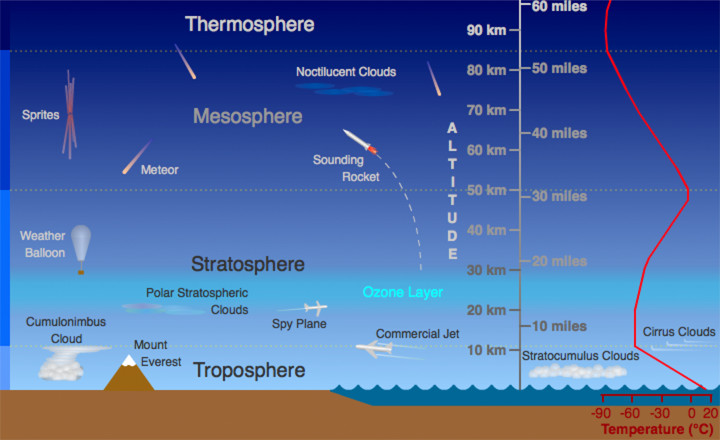
What is weather? What is the difference between weather and climate?
Earth is surrounded by a thin envelope of gases, the atmosphere. The term weather is used to describe the state of the atmosphere at a given moment. Weather is the day-to-day state of the atmosphere, and its short-term variation in minutes to weeks. Weather conditions include the distribution and intensity of wind, air pressure, humidity, cloud cover and precipitation among others. Climate is the statistics of these conditions, including their variability, mean and extremes, measured over an extended period of time, often 30 years. We talk about climate change in terms of years, decades, and centuries. Scientists study climate to look for trends or cycles of variability.
The Atmosphere
Earth is a system consisting of five distinct components that permanently interact through the exchange of mass and energy: atmosphere (air), lithosphere (land), hydrosphere (liquid water), cryosphere (ice), and biosphere (life). As a whole, this system is in quasi-equilibrium, fueled by incoming energy from the Sun. Uneven heating of the land and oceans by the Sun is what creates weather.
All planets in our solar system have gravitational forces strong enough to maintain an atmosphere. An atmosphere is a mixture of gases that surrounds and protects a planet. Compositions of an atmosphere varies due to gravitational differences. Our Earth too, has an atmosphere. Air density and pressure decrease with height. Earth’s atmosphere consists of distinct layers that are characterized by their temperature profiles: the troposphere, the stratosphere, mesosphere, thermosphere and exosphere. The well-defined boundaries between the layers use the suffix ‘pause’. There is no boundary between the atmosphere and outer space. Molecules become simply more and more rare. These are the different layers of the atmosphere:
- Troposphere: The lowest layer reaches from sea-level to 7 kilometers at the Poles, and up to 17 kilometers at the Equator. Being the lowest level of the atmosphere, the troposphere, contains 90% of its mass and the vast majority of atmospheric water. Nearly all weather develops in the troposphere. This layer is characterized by strong convection, a heat-driven process that causes warmer air to rise and cooler air to sink. The base of this layer is warmer than its top because the air is heated by the surface of the Earth, which absorbs the incoming Sun’s energy.
- Stratosphere: Above the troposphere lies the stratosphere. This is where jet airplanes fly. The ozone layer lies within the stratosphere. It absorbs harmful ultraviolet rays. Due to absorption of Ultraviolet radiation, in the ozone layer, temperatures in the stratosphere increase with height.
- Mesosphere: Frictional heating caused by high air density in the mesosphere incinerates meteors at-casinos.com/. As this layer extends upward temperatures decrease. The coldest parts of our atmosphere are located in this layer and can reach –90°C.
- Thermosphere: In the forth layer from Earth’s surface, the thermosphere, the air is thin, meaning that there are far fewer air molecules. The thermosphere is very sensitive to solar activity and can heat up to 1,500°C when an aurora is active. Astronauts orbiting Earth in a space station spend their time in this layer.
- Exosphere: The upper layer of our atmosphere, where atoms and molecules escape into space, is referred to as the exosphere.

In next week’s post we’ll be dealing with the Sun and the role it plays in the Earth’s Energy Cycle.


0 comments
Write a comment